 |

State of Alaska > DOLWD > Alaska
Economic Trends
2017 Alaska Economic Trends
Alaska Economic Trends is a monthly magazine that covers a broad range of economic issues.
Click here to sign up for a free electronic subscription. 
Click here for a paid print subscription.
Alaska Economic Trends are searchable from 1978 to the present using the Trends search page. The search can include any combination of the title or subtitle, date or date range, author, or full text.
|
| December 2017 |
10 Possible Reasons
Unemployment Insurance Claims are Low |
 |
It’s no secret that the state is in a recession. Alaska has been losing jobs since the fourth quarter of 2015, and total and average wages have both declined.
At the same time, Alaska’s unemployment rate has slowly increased from a low of 6.4 percent in mid-2015 to 7.2 percent in October 2017. This triggered extended benefits for unemployment insurance, effective as of November. EB allows for up to an additional 13 weeks of benefits on top of the regular allowed maximum of 26 weeks.
December 2017 Trends |
| |
|
| November 2017 |
Commercial Fishing Employment |
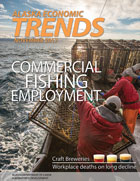 |
Alaska’s seafood harvesting employment fell by 5 percent from 2015 to 2016. The job losses were mostly in salmon fishing, which had hit record employment the year before.
While total employment remains above average historically, 2016 marked a second year of overall loss. The modest decline in 2015 was mostly in groundfish harvesting.
November 2017 Trends |
| |
|
| October 2017 |
Job Turnover |
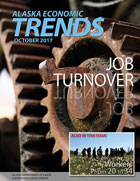 |
One way to describe job turnover is the flow of workers in and out of a business. One of the reasons this matters is that it creates costs, both in lost sales or productivity while a position is vacant and also in recruitment and training of new workers. Another reason is it tends to create disruptions in the delivery of an employer’s goods or services.
October 2017 Trends |
| |
|
| September 2017 |
The Mat-Su Economy |
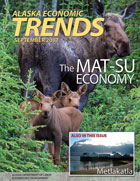 |
For decades, the Matanuska-Susitna Borough has been the state’s hot spot for growth. Between 2010 and 2016, its population grew by 15 percent while the state as a whole grew by 4 percent and nearby Anchorage by just 2 percent.
The borough has also long led the state for new home construction. In 2016, nearly half of Alaska’s new housing units were built in Mat-Su.
September 2017 Trends |
| |
|
| August 2017 |
The 2017 Rental Market |
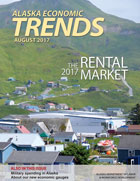 |
The rental housing market hasn’t suffered significant setbacks as a result of the recession and
area markets vary, but the overarching trend of near-flat rents and increased vacancies indicate the
market is softening.
According to the March 2017 rental survey, Alaska’s average rent for all unit types plus utilities increased by just $7, or 0.6 percent, from last year. The overall vacancy rate rose from 5.8 percent to 7.3 percent.
August 2017 Trends |
| |
|
| July 2017 |
The Cost of Living |
 |
Alaska’s energy prices dropped again in 2016, spurring the smallest increase in overall costs since 1988 and the second year in a row under 1 percent.
In Anchorage, the only place in Alaska where the U.S. Bureau of Labor Statistics measures inflation, consumer prices went up 0.4 percent in 2016, far below its decade average of 2.1 percent and the nation’s increase of 1.3 percent.
July 2017 Trends |
| |
|
| June 2017 |
Does Working Reduce Recidivism? |
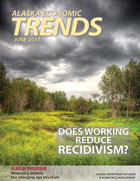 |
Former inmates face a number of obstacles when reintegrating into society and finding work after their release, and they are highly likely to return to prison. Of the 4,500 Alaska inmates who were released in 2012 after serving time for a felony, 43 percent were reincarcerated within the first year and 66 percent recidivated over the next three years.
June 2017 Trends |
| |
|
| May 2017 |
A Steady Housing Market |
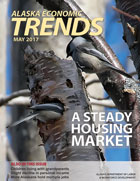 |
Although Alaska’s housing market appears to have slowed somewhat with the state recession, it shows no signs of decline.
Sales prices and rents are stable and foreclosures are down. Fewer new units are being built and sales volume is lower, but that may be helping the market stabilize by reducing supply.
May 2017 Trends |
| |
|
| April 2017 |
Other States' Recessions |
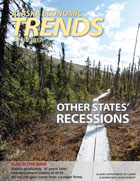 |
Alaska has been losing jobs for roughly a year and a half, precipitated by a drop in oil prices and a host of downstream effects. Job losses are already the worst since Alaska’s deep recession of the late 1980s, and show no signs of ending soon.
The state has had three distinct recessions since 1961, with the longest period of job loss a little more than two years. Over that same period, the U.S. sustained six recessions, all of them lasting less than two years.
April 2017 Trends |
| |
|
| March 2017 |
The Gender Wage Gap |
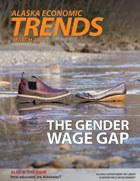 |
The average woman who worked in Alaska in 2015 earned $34,333, and there was nearly a 50 percent chance she worked in health care or in state or local government. She also made 68 percent of what the average Alaska man earned.
Men earn more in nearly 80 percent of Alaska’s occupations and at every age and educational level, even though men and women participate in the workforce at nearly equal rates and work the same number of quarters per year. Forty-eight percent of the state’s workers were women in 2015, but they made 38 percent of total wages.
March 2017 Trends |
| |
|
| February 2017 |
Ups and Downs for Oil Industry Jobs |
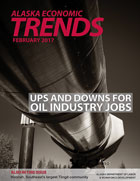 |
The decline in oil prices over the last couple of years led to major job losses for the oil and gas industry in Alaska in 2016. As of June, the industry’s employment had fallen to 11,100 after reaching a record monthly average of 14,100 in 2015.
Fluctuation is nothing new for Alaska oil industry employment, which has waxed and waned for decades.
February 2017 Trends |
| |
|
| January 2017 |
Employment Forecast for 2017 |
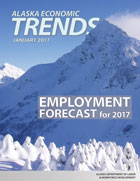 |
In 2016, job losses spread through nearly all sectors of Alaska’s economy, and more broad-based decline is forecasted for 2017.
Employment losses began in the last months of 2015 in the industries directly related to oil production, after prices fell. Initial loss was limited to the oil and gas industry and closely related sectors, including construction, professional and business services, and state government. In 2016, losses spread into sectors not directly related to the oil industry.
January 2017 Trends |
| |
|
Return to Top of Page
|
















